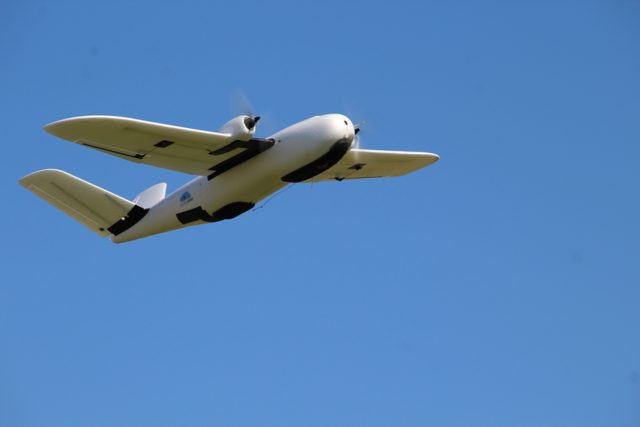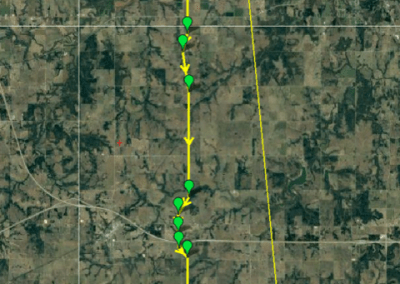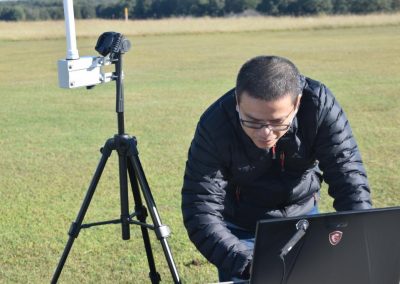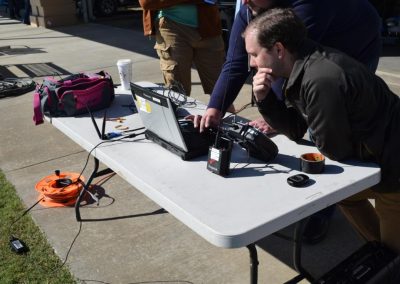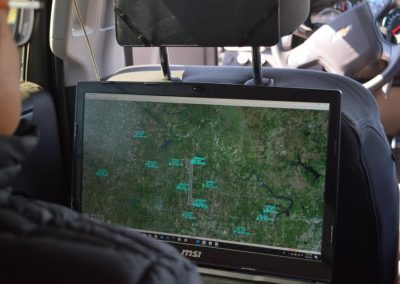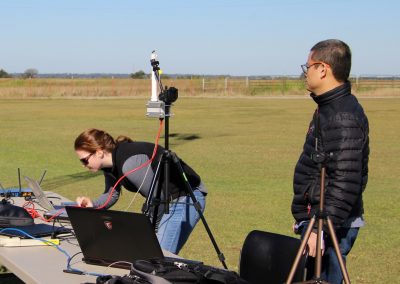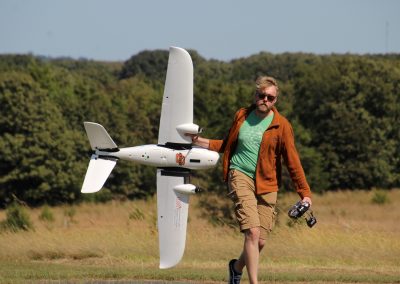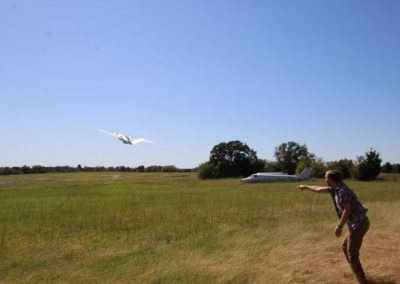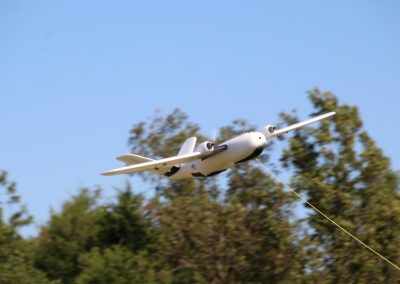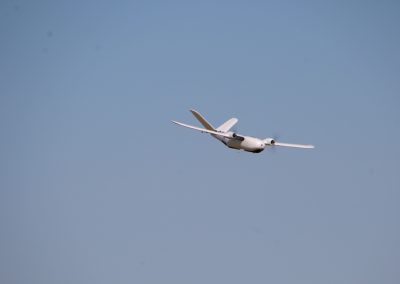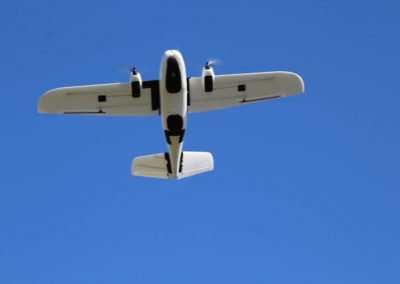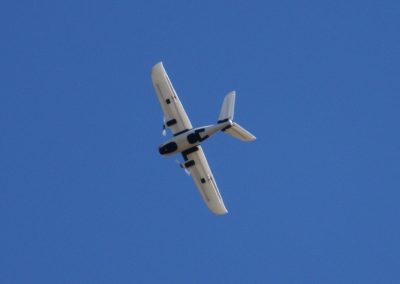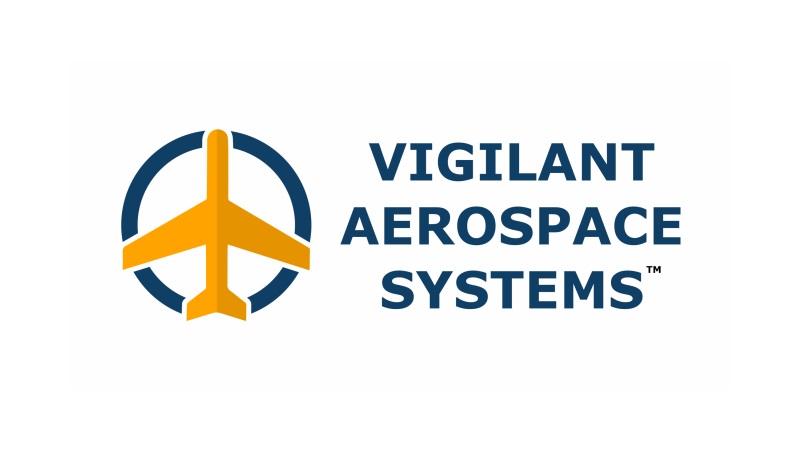On October 8, 2019, Oklahoma State University (OSU) and Vigilant Aerospace Systems (Vigilant) conducted a demonstration flight utilizing OSU’s 13-mile beyond visual line-of-sight (BVLOS) corridor east of Stillwater, Oklahoma.
The demonstration was used to evaluate BVLOS capabilities and to demonstrate Vigilant’s latest FlightHorizon software which provided airspace situational awareness throughout the flight.
The flight was the first full exercise of the FAA-authorized 13-mile unmanned aircraft system (UAS) flight corridor located in central Oklahoma. The flight was also a major field test for FlightHorizon 2, the latest version of Vigilant Aerospace’s award-winning unmanned traffic management and active detect-and-avoid (aDAA) system.
The completely autonomous flight was over 18-miles long in total, starting at OSU’s Center for Forensics Explosives range near Pawnee, Oklahoma and culminating in an autonomous landing at OSU’s Unmanned Aircraft Flight Station in Glencoe, Oklahoma.
“The unmanned aircraft industry’s top needs continue to be autonomous safety systems, on-board detect-and-avoid solutions and better unmanned traffic management. This flight allowed us to make progress on all three by demonstrating our system’s capabilities over a much longer duration and greater distances while providing active alerting and airspace visualization to the pilot and observers,” said Kraettli L. Epperson, CEO of Vigilant Aerospace.
“These demonstration flights are critical milestones in the development of the industry and our partnership with OSU provides our company access to some of the top students, researchers and facilities in the US,” said Epperson.
The results from the flight provided a proof of concept for Vigilant’s Unmanned Traffic Management (UTM) capabilities currently in research and development, and will provide the basis for initial deployment of UTM capabilities utilizing FlightHorizon.
The analysis of results from the demonstrations will also provide an understanding of the capabilities of autonomous UAS operations and provide data necessary for additional use cases.
The flight is the first in a new series that will be testing radar integration, ground-based and on-board autonomous detect-and-avoid capabilities, remote ID solutions and UTM processes utilizing FlightHorizon. See prior post on FlightHorizon 2.
“This flight and the team of OSU research engineers and students and Vigilant Aerospace staff who conducted it represent a forward-looking approach to utilizing public-private partnerships to rapidly advance the technology and bring innovations to market,” said Jamey Jacob, Director of the OSU Unmanned Systems Research Institute (USRI) and John Hendrix Chair Professor in Mechanical and Aerospace Engineering.
The flight was conducted with a twin-motor UAS operating below 400 feet AGL and was conducted under an FAA Certificate of Authorization (COA) with a visual observer. The COA, released by the FAA in December 2018, allows for the waiving of rules requiring drone pilots to keep their aircraft continuously in line-of-sight and also provides additional operating altitude.
The COA allows OSU and commercial research and development partners like Vigilant Aerospace to pioneer new unmanned flight technologies, safety systems and processes to advance the state of the UAS industry.
“This flight authorization is well-suited to the development and demonstration of systems for safe BVLOS flights over long distances, which are critical for monitoring assets like oil and gas wells, pipelines, wind and solar farms, storage tanks, power lines, farms and ranches, and roads and bridges,” said Epperson.
Using it’s FlightHorizon 2 software, Vigilant Aerospace provided airspace situational awareness, detect-and-avoid and air traffic visualization for the flight. The software tracked dozens of manned aircraft across central Oklahoma during the flight and provided real-time alerting to the visual observer and pilot-in-command.
About the OSU School of Mechanical and Aerospace Engineering
From the website:
The Oklahoma State University School (OSU) of Mechanical and Aerospace Engineering (MAE) instructs and encourages students to reach full potential in technical expertise, innovative expression, intellectual curiosity, and collaborative design. MAE’s mission is to prepare engineers that are competitive nation-wide and internationally for employment opportunities and who will become respected achievers within their discipline and prepared for a lifetime of continuing development. For more information on the OSU School of Mechanical and Aerospace Engineering, visit MAE.okstate.edu.
About the Oklahoma Center for the Advancement of Science & Technology (OCAST)
From the website: The Oklahoma Center for the Advancement of Science and Technology (OCAST) was established in 1987 by the Oklahoma legislature for the purpose of growing and diversifying the state’s economy through technology development, technology transfer and technology commercialization. OCAST’s was founded with the purpose of expanding and diversifying Oklahoma’s economy and providing new and higher quality jobs for Oklahomans by encouraging the development of new products. OCAST also is an active supporter of STEM education across Oklahoma’s common education system and provides funding to support internships between local industries and higher education. For more information on OCAST, visit www.OK.gov/OCAST
The Oklahoma Center for the Advancement of Science and Technology (OCAST) was established in 1987 by the Oklahoma legislature for the purpose of growing and diversifying the state’s economy through technology development, technology transfer and technology commercialization. OCAST’s was founded with the purpose of expanding and diversifying Oklahoma’s economy and providing new and higher quality jobs for Oklahomans by encouraging the development of new products. OCAST also is an active supporter of STEM education across Oklahoma’s common education system and provides funding to support internships between local industries and higher education. For more information on OCAST, visit www.OK.gov/OCAST
About Oklahoma Applied Research Support (OARS)
The Oklahoma Applied Research Support (OARS) program is an OCAST funding program that invests in research and development supporting innovative technologies with commercial potential. This funding is designed to increase investment in the R&D of new technologies that will ultimately bring value to the state of Oklahoma and help grow and diversify the state’s economy. Oklahoma public or private colleges/universities, non-profit research institutions, and private enterprises with the principal place of business in Oklahoma are all eligible to apply for OARS funding. To learn more about OARS, visit the program website.
About Vigilant Aerospace Systems
Vigilant Aerospace Systems is a private company headquartered in Oklahoma City, Oklahoma providing software and services worldwide. In addition to the FlightHorizon system, the company also provides integration and development consulting, testing, training and compliance services for unmanned aircraft flight operations and fleet managers. For more information on Vigilant Aerospace Systems and FlightHorizon detect-and-avoid and airspace management system, visit our website at www.VigilantAerospace.com
About FlightHorizon
FlightHorizon is a situational awareness and safety system for airspace management. The system provides airspace managers with either a 2D or 3D view of all aircraft in the selected airspace using a combination of sensors and data sources to create an airspace safety picture for pilots, airspace managers and command centers.
 The system is based on an exclusively licensed NASA patent and prototype that has been used in extensive flight testing, including beyond visual line-of-sight (BVLOS) flight testing at NASA Armstrong Flight Research Center and at the OSU Unmanned Aircraft Flight Station.
The system is based on an exclusively licensed NASA patent and prototype that has been used in extensive flight testing, including beyond visual line-of-sight (BVLOS) flight testing at NASA Armstrong Flight Research Center and at the OSU Unmanned Aircraft Flight Station.
FlightHorizon functions as both a visualization tool for airspace management, an active situational awareness tool and as a detect-and-avoid system that enables unmanned aircraft to avoid other aircraft and keeps drone pilots and airspace managers aware of the location and air traffic around their UAS and in their airspace. The system provides the ability to designate one or more aircraft as “ownship” and to track those aircraft specifically for collision avoidance and provides self-separation advisories for those aircraft, including visual cues, on-screen text warnings and audible advisories. FlightHorizon is also designed to help users to better meet civil aviation authority regulations and requirements and to reduce risk. It can also improve the relative competitiveness of subscribing airparks in attracting UAS operators and service providers. For more information on FlightHorizon, visit our Products and Services page.
Read OSU’s announcement here: “Vigilant Aerospace demonstrates FlightHorizon 2 in autonomous 18 mile flight with OSU”
Flight Test Images:
DSC_0003_compress
Vigilant Aerospace Systems setting up and running systems checks with FlightHorizon before the flight operations.
DSC_0025_compress
OSU flight team setting up for a full systems check for the fully autonomous flights.
DSC_0034_compress
Vigilant Aerospace Systems’ CEO Kraettli Epperson reviewing equipment and systems on-site at the OSU Unmanned Aircraft Flight Station before the flight operations.
DSC_0080_compress
Vigilant Aerospace Systems monitoring the airspace for the flight using FlightHorizon 2
2019.10.08 – Vigilant Aerospace – OSU BVLOS Flights – OSUIMG_5390_crop_1720x1147 high res
Vigilant Aerospace Systems’ team setting up FlightHorizon and receivers for the flight operations at OSU’s Unmanned Aircraft Flight Station. Photo Credit: Dr. Jamey Jacob/OSU
2019.10.08 – Vigilant Aerospace – OSU BVLOS Flights – OSUIMG_5427_1711x1140 high res
OSU flight team setting up the Believer UAS for the flight. Photo Credit: Dr. Jamey Jacob/OSU
2019.10.08 – Vigilant Aerospace – OSU BVLOS Flights – OSUIMG_5408_1711x1140 high res
OSU launching the unmanned aircraft at the OSU’s Center for Forensics Explosives range near Pawnee, Oklahoma. Photo Credit: Dr. Jamey Jacob/OSU
image010
OSU launching the unmanned aircraft at the OSU’s Center for Forensics Explosives range near Pawnee, Oklahoma. Photo Credit: Dr. Jamey Jacob/OSU
2019.10.08 – Vigilant Aerospace – OSU BVLOS Flights – OSUIMG_5409_1711x1140 high res
OSU twin-motor UAS flying the 18-mile demonstration flight on Oct. 8, 2019. Photo Credit: Dr. Jamey Jacob/OSU
2019.10.08 – Vigilant Aerospace – OSU BVLOS Flights – OSUIMG_5421_1711x1140 high res
OSU twin-motor UAS flying the 18-mile demonstration flight on Oct. 8, 2019. Photo Credit: Dr. Jamey Jacob/OSU
Demonstrates FlightHorizon 2 in Autonomous 18-Mile Flight with Oklahoma State University
OSU twin-motor UAS flying the 18-mile demonstration flight on Oct. 8, 2019.
*** UPDATE ***
Media Coverage:
- “Vigilant Aerospace Demonstrates FlightHorizon 2 in Autonomous 18-Mile Flight with Oklahoma State University.” sUAS News; 10 October 2019.
- “Testers Achieve Autonomous, Long-Distance Drone Flight.” Aviation Week; 10 October 2019.
- “Oklahoma State University teams up with Vigilant Aerospace Systems for demonstration flight.” Commercial Drone Professional; 11 October 2019.
- “OSU and Vigilant Aerospace carry out drone demonstration near Stillwater.” OK Energy Today; 11 October 2019.
- “Drone technology company partners with OSU.” The Oklahoman; 11 October 2019.
- “Aerospace & Defense Roundup: Testers Achieve Autonomous, Long-Distance Drone Flight.” Aviation Week Network; 11 October 2019.
- “Vigilant Aerospace Demonstrates FlightHorizon 2 in Autonomous 18-Mile Flight.” UAS Weekly; 12 October 2019.
- “Oklahoma test corridor conducts first BVLOS flight.” Unmanned Airspace; 14 October 2019.
- “Vigilant Aerospace, OSU drone flies 18 miles by itself.” The Oklahoman; 15 October 2019.
- “Oklahoma State Completes 18-Mile Autonomous Drone Demo.” Unmanned Aerial; 16 October 2019.
- “Oklahoma State University, Vigilant Aerospace Systems Conduct Autonomous Demonstration Flight at OSU’s BVLOS Corridor.” AUVSI; 16 October 2019.
- “Autonomous 18-Mile BVLOS UAS Flight Conducted.” Unmanned Systems Technology (UST); 18 October 2019.
- “Vigilant Aerospace Performs 18-Mile Autonomous Flight with Oklahoma State University.” UAS Vision; 18 October 2019.
- Video: “AUVSI Weekend Roundup 10-18-19.” AUVSI; 18 October 2019.
Social Media Coverage
Vigilant Aerospace Demonstrates FlightHorizon 2 in Autonomous 18-Mile Flight with Oklahoma State University https://t.co/JINDsRtay5 pic.twitter.com/Kpb2L3VvVN
— sUAS News (@sUASnews) October 10, 2019
Congratulations @VigilantAero and @okstate! These two continue proving Oklahoma as a leader in unmanned/autonomous technology development. #OKACES #OKaerospace #OKtop10 #drone #UAV https://t.co/PuexZSeZ1n
— Oklahoma ACES (@ACESoklahoma) October 14, 2019
✈️ OSU’s Unmanned Systems Research Institute and Vigilant Aerospace conducted a first-of-its-kind, beyond-visual-line-of-sight test this week! Click here for the full story!!! ✈️ https://t.co/uvIo7twax9
— OSU CEAT (@OSU_CEAT) October 10, 2019
Oklahoma State University teamed with Vigilant Aerospace Systems to demonstrate detect-and-avoid technology on long distance autonomous flights. https://t.co/Libc0Z32HD via @cdronepro
— PJ Tikalsky (@PJ_Tikalsky) October 11, 2019


